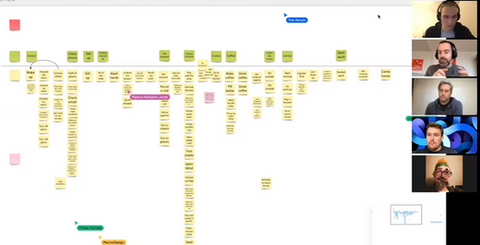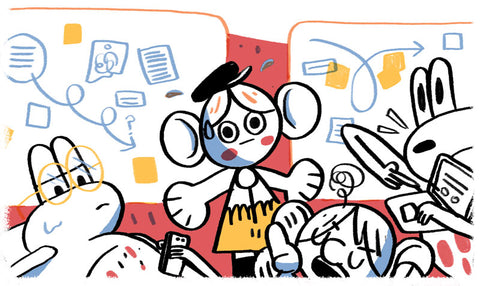In January 2019, I contracted as a UX consultant at the Co-op Bank. A large part of my job was to run workshops that helped product teams focus on what was important.
I kept being asked where I learnt to run these workshops. More pressingly: how did I know what kind of session to run, and when?
The idea for Workshop Tactics presented itself: put all the product design related workshops I rely on in one place - and make it shareable and accessible.
So I curated a list of workshops.

I felt pretty good about it - but instead of writing the 'simple and accessible' content for each tactic, I obsessed over finding the right name and developing the brand. Typical designer!
This was bad. I procrastinated further by pissing around in code-land. I spent a month building a really slick filtering system in a WordPress theme, without anything of real substance.
I had done this countless times. Get an idea, and avoid the hard work to make it happen.
After weeks of idling away, I became frustrated with myself. I had run the idea past the people I worked with, and the response seemed promising. However, I didn't know if it was something the world outside the office would be interested in.
So I deleted everything and started from scratch.
I had already curated a list of workshops, I just needed to write the content. After all, that was the core of the product.
But I didn’t do that either.
Instead, I did something else. I did the bare minimum to validate the idea, before spending any more time on it. Something I should’ve done weeks ago!
I imagined Workshop Tactics as a physical card deck, mocked it up in Cinema4D.

Next I put together a crude landing page on Shopify. Creating the landing page made me focus intensely on the content, and more importantly, the value proposition of the cards:
• Who are they for?
• What problem do they solve?
• How will they change or elevate someone in their life?
Here’s an early version of the Workshop Tactics landing page (click the image to see the full landing page).

Since then, I've pivoted away from the very broad notion of “unproductive meetings” and instead focused more on a particular segment (product designers) and the specific result (better designed products). I'll write how and why I did so at a later date. Join my mailing list and you'll get it in your inbox when I do!
To measure interest, I set up an email capture form. This would prove valuable later as building an audience early on is vital if you want to launch any product.
The next challenge: how would I get traffic to the page?
There was one sure-fire away, and that was ads. I spent a total of £400 on LinkedIn ads, targeting people with job titles such as “UX Designer” and ‘Product Manager”. While pricey, I treated it as the cost of learning whether to continue or not.
Writing the ad copy helped me refine the value proposition, which was an unexpected but welcomed side-effect of testing this exercise.
I created several variants of each proposition. With and without a call-to-action, with various different copy in the button. As you might predict, the ads with a call-to-action performed far better than those without.
When I launched the ads, the analytics of the landing page lit up. I learned which value proposition worked for which customer. It turns out that A/B testing adverts is a great way to test the value proposition for a non-existent product.
I got a 20% conversion rate of email sign-ups, and soon I had an email subscriber list of 150 people who said they were interested in Workshop Tactics!
I wanted to make sure the first version of the product met their needs - and wasn’t just another navel-gazing exercise like the WordPress site was. So, I sent a pretty basic survey to understand more about the people who had signed up.
Of the 150 people, 90 signed up to be ‘alpha’ testers; people that would pilot the first prototype of the product. I also learned a tonne about their previous workshop experience, and what problem they think it would solve for them.
The game was afoot! The confidence this gave me to pursue the idea was invaluable. No longer was I pretending to make a product. I had real people and real data telling me it would be worth my time to keep going.
Even better still, I had a pool of potential customers to help me develop the product. The biggest thing I learnt is that launching a product to crickets is fatal. You must first build an audience, so I was already on my way!
So in summary, to validate my product idea, I took the following steps:
- Created a free Shopify landing page with email capture
- Developed an early version of the brand
- Mocked up a 3D visualisation of the product
- Wrote a value proposition
- Honed in on a target customer
- Ran ads (and iterated the value proposition) and collected emails
- Surveyed my potential customers to learn even more
However, I hadn’t validated if anyone would actually buy the product yet. So my next question to answer is: would my audience buy it, and if so, for how much?
Read next: Why do people buy Workshop Tactics when it’s available for free?









